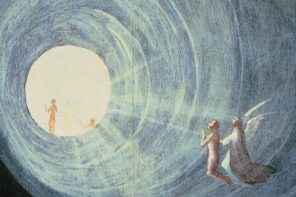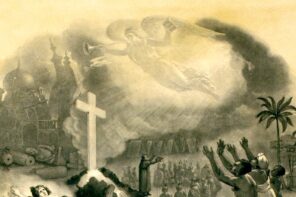I am now the guardian of a Vodou doll that has wreaked havoc at my university. I first learned of him last week, when a colleague in the art history department sent me a mysterious message. Could she bring him by so I could take a look at him? She did not disclose where he came from or how he ended up over at art history instead of my own department, religious studies.
Both my research and personal interest were piqued, and I invited them over for Friday—but on that morning I ran into some difficulty. My husband’s car would not start; the doll would have to wait. I called my colleague and suggested a Monday meeting. She took the news a bit ominously, mentioning that other faculty had been having “bad luck” since his arrival in their lives.
Monday morning I waited with eager anticipation for my colleague’s arrival. I must confess that I was ready to wow her with my expertise of Afro-Caribbean religion. I must also admit I was expecting an elaborate doll, one worthy of inspection by professors of the fine arts. Instead, I was handed a Kodak slide tray box containing a medium-sized cloth doll, along with a bag of candy corns. His eyes are two slits of white thread, his pants, hat, and scarf are red, his shirt a light purple. He looks like something you would buy at a tourist stand. In fact, as I gazed at him, that is where I assumed he came from.
But no. He was discovered by workmen. The computer in one of the university’s classrooms had been crashing, and no one could fix it. Finally a tech person came and took the computer out of its cabinet. There he was, wedged behind it. The computer was fixed.
My colleague did not want to leave him to perform any more mischief so he was brought to her department. Faculty were not pleased; a modernist in the department said to “get rid of him.” Others joined in to demand his exit. As a way of appeasing him, someone gave him an offering of candy corn. And then he came to me. He had nowhere else to go. It was either I take him, or the plan was to dig a hole, pour some rum and gunpowder on him, and bury him. The idea of PhDs sitting around plotting the burial and destruction of a doll makes me smile even now. I thought that sort of irrational superstition only happened in religious studies—apparently, we are not alone.
Vodou dolls and zombies are associated with the Hollywood popularization and vilification of Vodou, a rich African Diaspora religion that is too often reduced to witchcraft and sorcery. As a scholar that works on Afro-Caribbean religion, I cannot tell you how many times I get calls from journalists wanting me to denounce Vodou, describe it as satanic, list it as a possible explanation for a case of torture or ritual death.
When I teach students about Vodou they are intrigued and often fearful; field trips to Vodou house temples evoke an excitement that no visit to a church ever provokes. When I teach Catholicism, I do not get inundated with emails from undergrads asking to meet a priest. When I teach about Vodou (and consequently Santería), I get flooded with desperate emails asking me to reveal the name of a “good” Vodou priest that can give them a spiritual consultation or help them with a “spell.” I do not associate Vodou with superstition, but too often I find it reduced to superstition or “black” magic.
I have searched long and hard for the origins of Vodou doll mythology. La Regla de Palo Monte, whose origins are Bantú (sub-Saharan African), is an Afro-Cuban religion. The name Palo comes from practitioners’ use of branches and trees. While the various religions described as Reglas de Congo have their origins in the Congo region, in Cuba they have been decidedly influenced by Yoruba religion. Palo Monte ritual centers around the Nganga. In Bantú religion nganga refers to priests or ritual leaders; however, in Cuba it came to refer to the cauldron used in Palo Monte ritual practices. This cauldron carries relics, most often a skull, of a deceased person with whom a priest has entered a ritual contract. Also, some paleros were known to make figures to attack enemies, such as their slave masters. This is perhaps the origin of the contemporary mythology behind the pop-culture Vodou doll. The collapse of two African religious traditions—one Cuban, one Haitian—does not surprise me.
The doll who sits in my office is not the type of doll you stick needles in. I am not even sure he is a Vodou doll. And yet, his black cloth skin and his scarf evoked feelings of fear and mistrust among a group of university professors. The mythology of evil surrounding Vodou, surrounding black religion, remains. I have nestled him between an image of the Mayan god Maximon and an image of the Yoruban orisha Bablú Ayé. I decided he would feel at home with other marginalized and often misinterpreted religious figures.
He has been with me now for twenty-four hours. I am happy to say, as a type this reflection, that my computer is working fine.




